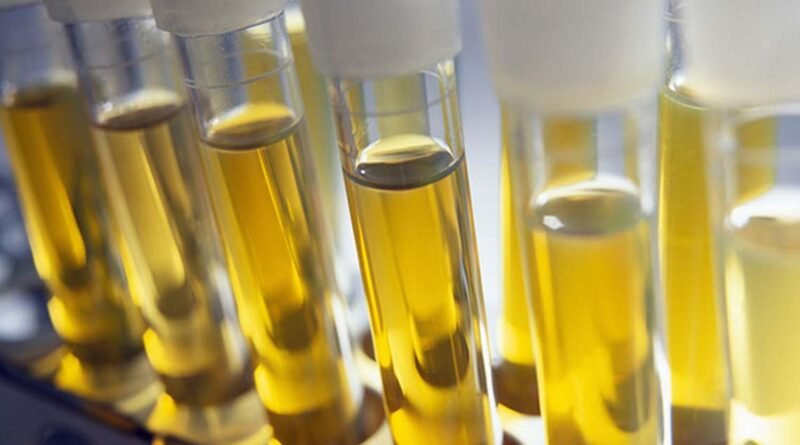5 Hiaa Urine Test What Is Normal Range

Urine Test: Normal Lab Values
Test | Specimen | Conventional Units | SI Units |
| Aldosterone | Urine, 24 h | 5–19 mcg/24 h | 13.9–52.6 nmol/24 h |
| Amino acids, total | Urine, 24 h | 200–400 mg/24 h | 14–29 nmol/24 h |
| Amylase | Urine, timed | 6.5–48.1 U/h | — |
| Calcium (unrestricted diet) | Urine, timed | 100–300 mg/day | 2.5–7.5 mmol/day |
| Catecholamines, total | Urine, 24 h | < 100 mcg/m2/24 h | < 591 nmol/m2/24 h |
| Chloride | Urine, timed | 80–250 mEq/day | 80–250 mmol/day |
| Copper | Urine, 24 h | 0–100 mcg/24 h | 0–1.6 mcmol/24 h |
| Coproporphyrin | Urine, 24 h | 50–250 mcg/24 h | 76–382 nmol/24 h |
| Cortisol, free | Urine, 24 h | < 90 mcg/24 h | < 248 nmol/24 h |
| Creatine: | |||
| * Females | Urine, 24 h | 0–100 mg/24 h | 0–763 mmol/24 h |
| * Males | Urine, 24 h | 4–40 mg/24 h | 30–305 mmol/24 h |
| Creatinine, weight-based | Urine, 24 h | 15–25 mg/kg/24 h | 133–221 mmol/kg/ 24 h |
| d-Xylose excretion 5 h after ingestion of 25 g of d-xylose | Urine, 5 h collection | 5–8 g | 33–53 mmol |
| Estriol, females | Urine, 24 h | > 12 mg/24 h | > 42 mcmol/24 h |
| 17-Hydroxycorticosteroids, fractionated, adults ≥ 18 yr: | |||
| * Cortisol | Urine, 24 h | 3.5–4.5 mcg/24 h | 9.7–12.4 nmol/24 h |
| * Cortisone | Urine, 24 h | 17–129 mcg/24 h | 47–359 nmol/24 h |
| 5-Hydroxyindoleacetic acid (5-HIAA) | Urine, 24 h | 2–9 mg/24 h | 10.4–46.8 mcmol/24 h |
| 17-Ketosteroid, fractionated, females > 12 yr: | |||
| * Androsterone | Urine, 24 h | 55–1589 mcg/24 h | — |
| * Pregnanetriol | Urine, 24 h | 59–1391 mcg/24 h | — |
| 17-Ketosteroid, fractionated, males > 12 yr: | |||
| * Androsterone | Urine, 24 h | 234–2703 mcg/24 h | — |
| * Etiocholanolone | Urine, 24 h | 151–3198 mcg/24 h | — |
| * 11-Hydroxyandrosterone | Urine, 24 h | 66–1032 mcg/24 h | — |
| * 11-Hydroxyetiocholanolone | Urine, 24 h | 17–1006 mcg/24 h | — |
| * 11-Ketoandrosterone | Urine, 24 h | 4–55 mcg/24 h | — |
| * 11-Ketoetiocholanolone | Urine, 24 h | 51–1016 mcg/24 h | — |
| * Pregnanetriol | Urine, 24 h | 245–1701 mcg/24 h | — |
| Metanephrines, fractionated, normotensive patients ≥ 18 yr: | |||
| * Females, metanephrine | Urine, 24 h | 30–180 mcg/24 h | — |
| * Females, total metanephrines | Urine, 24 h | 142–510 mcg/24 h | — |
| * Males, metanephrine | Urine, 24 h | 44–261 mcg/24 h | — |
| * Males, total metanephrines | Urine, 24 h | 190–583 mcg/24 h | — |
| Metanephrines, fractionated, normotensive males and females aged 18–29 yr: | |||
| * Normetanephrine | Urine, 24 h | 103–390 mcg/24 h | — |
| Metanephrines, fractionated, hypertensive males and females: | |||
| * Metanephrine | Urine, 24 h | < 400 mcg/24 h | — |
| * Normetanephrine | Urine, 24 h | < 900 mcg/24 h | — |
| * Total metanephrines | Urine, 24 h | < 1300 mcg/24 h | — |
| Microalbumin | Urine, 24 h | < 30 mg/24 h | — |
| Microalbumin, albumin/ creatinine ratio | Urine, random | < 20 mcg/mg | — |
| Osmolality | Urine, random | 38–1400 mOsm/kg H2O | — |
| Oxalate | Urine, 24 h | 0.11–0.46 mmol/ specimen* | — |
| Phosphate, tubular reabsorption | Urine, random | 79–94% of filtered load | — |
| Porphobilinogens | Urine, random | 0–0.5 mg/g creatinine | — |
| Potassium | Urine, 24 h | 25–100 mEq/24 h | 25–100 mmol/24 h |
| Protein, total | Urine, 24 h | < 100 mg/24 h | — |
| Sodium | Urine, 24 h | 100–260 mEq/24 h | 100–260 mmol/24 h |
| Uric acid | Urine, 24 h | 250–750 mg/24 h | 1.48–4.43 mmol/24 h |
| Urinalysis, routine† | |||
| * pH | Urine, random | 5–7 | — |
| Urinalysis, routine, dipstick testing†: | |||
| * Bilirubin | Urine, random | Negative | — |
| * Blood | Urine, random | Negative | — |
| * Glucose | Urine, random | Negative | — |
| * Ketones | Urine, random | Negative | — |
| * Leukocyte esterase | Urine, random | Negative | — |
| * Nitrites | Urine, random | Negative | — |
| * Protein | Urine, random | Negative | — |
| * Urobilinogen | Urine, random | 0.2–1.0 EU | — |
| Urobilinogen | Urine, 24 h | 0.05–2.5 mg/24 h | 0.08–4.22 mcmol/24 h |
| Vanillylmandelic acid (VMA) | Urine, 24 h | < 8 mg/24 h | < 40.4 mol/24 h |
| *Value is based on 24-h collection. *Normal findings detected by microscopic examination can include a few RBCs (especially in menstruating women), WBCs, epithelial cells, bacteria, yeast cells, crystals (eg, calcium oxalate, triple phosphate, amorphous phosphates, and urates), sperm, and unidentifiable materials. Large amounts of these substances or the presence of certain other materials may be abnormal. | |||
| EU = Ehrlich units. | |||
5 Hiaa Urine Test What Is Normal Range
Source: https://meefro.com/urine-test-normal-lab-values/